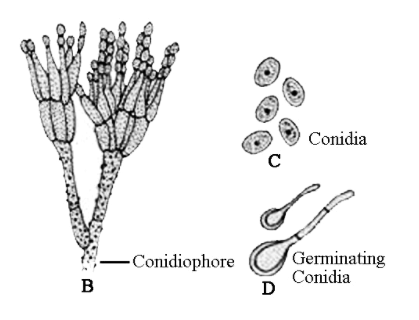Question
Question: How does Penicillium reproduce asexually?...
How does Penicillium reproduce asexually?
Solution
Hint: We commonly call Penicillium as blue or green mold. It is a genus of saprophytic fungi, which means it feeds on dead and decaying materials.
Complete answer:
We can find Penicillium fungus in the soil, air, on decaying fruits, vegetables, meat, etc. The unicellular, uninucleate, and non-motile spores of Penicillium are called conidia to undergo the asexual reproduction process.
The conidia are formed on conidiophore. Conidia are arranged in a basipetal manner. This means that we can find the younger conidia near the mother and older ones away from it. We can find at the tip of each metulae, the development of several flask-shaped phialides or sterigmata takes place. Each sterigmata develops at the tip.
During conidia development, sterigma tips swell up. Its nucleus undergoes mitotic division which results in two nuclei. Out of the two nuclei, one migrates into the swollen tip and by a partition wall. Now, the swollen region will separate from the mother and form the uninucleate conidium. We must know that the sterigma tip will again swell up and form the second conidia by following the same procedure.
The second conidium pushes the first one towards the outer side. This process repeats several times and thus forms the chain of conidia. The conidia once mature, will detach from the mother and be dispersed by wind.

Note: Apart from asexual reproduction, we must remember that the Penicillium can reproduce by the other two processes namely, vegetative and sexual reproduction.
Vegetative reproduction – This type of reproduction takes place by fragmentation. Each fragment separately develops and makes a complete mycelium.
Sexual reproduction – This type of reproduction takes place by the formation of ascospores. Antheridium is the male sex organ and ascogonium is a female sex organ. We can find the ascospores formed by the dissolution ascus.
